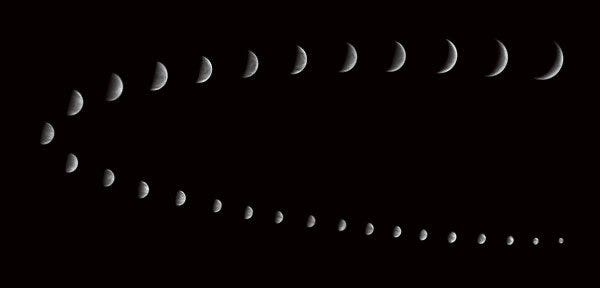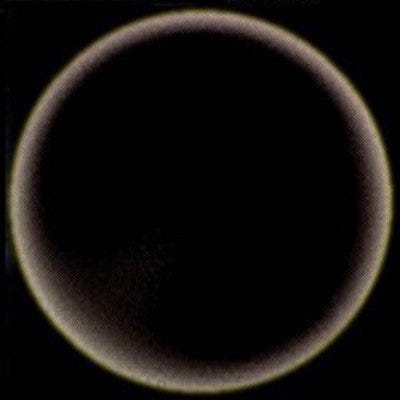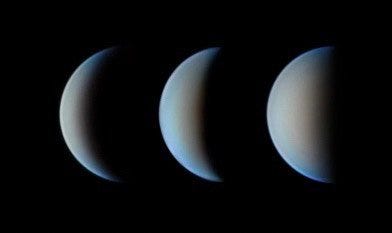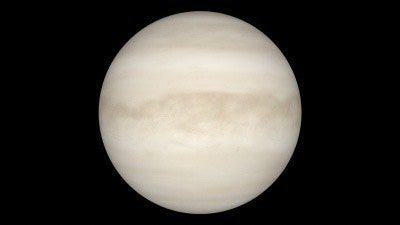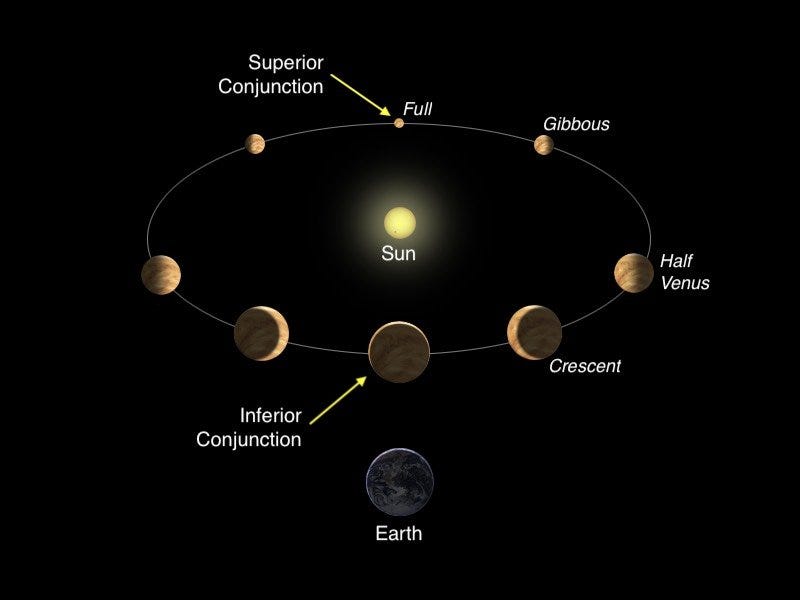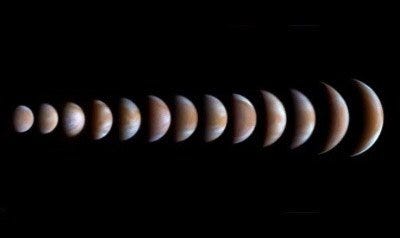Venus' synodic cycle is approximately 19 months (584 days) which can be divided by four primary visual phases. Each of these lasts around 146 days: New Venus, First Quarter Venus, Full Venus, and Last Quarter Venus. These are then subdivided to include the Waxing/Waning Crescent and Gibbous secondary phases.
In Ancient Astrology In Theory and Practice: A Manual of Traditional Techniques, Vol. 1 Chapter 25, Demetra George further outlines the Solar Phase Cycle aka the Synodic Cycle of the superior and inferior planets. For the inferior planets (Mercury and Venus) the synodic cycle unfolds its rhythm as follows:
LYING HIDDEN PHASE: The moment of the inferior Solar Conjunction, Cazimi (in the heart of the Sun), to the period of Combustion and being Under the Beams. Approximately from 12°–15° ahead of the Sun, Venus begins to emerge from under the beams and comes to a standstill.
HELIACAL-RISE TRANSITION: The first phasis moment. An Auspicious omen announcing Venus’ rebirth and increase in strength. The planet’s significations are intensified at this time.
MORNING-STAR PHASE: The period between their heliacal, morning rise to their morning setting. During this time Venus is visible, direct in motion and gaining in speed. Generally effective in bringing about their significations. Strongest and brightest at their greatest elongation.
MORNING-SETTING TRANSITION: The second phasis moment. Marks the moment when Venus makes its last visibility as a Morning Star and begins sinking under the Sun’s rays.
LYING HIDDEN PHASE: Venus now enters the second lying hidden phase. Invisible yet moving extra fast and direct in motion. Considered to have difficulty bringing forth its agendas.
EVENING-RISE TRANSITION: The third phasis moment. Venus emerges from beyond the beams of the Sun, appearing in the evening western sky, once again intensified.
EVENING-STAR PHASE: The period between the evening rise and the heliacal setting. Venus is generally effective during this time.
HELIACAL-SET TRANSITION: The fourth and final phasis moment. The combination of heliacal set and retrograde station gives a double intensification to its significations, but now the tendency is toward its ultimate weakness.
LYING-HIDDEN PHASE: Venus descends under the beams of the Sun, is very slow and retrograde in motion. This is the closing segment of the cycle. Repeat.
The New Venus phase takes place during the Lying Hidden Phase. The planet can be seen thru a telescope as a halo of its atmosphere refracting particles of light from it being relatively lower and closest to us between the Earth and the Sun at this time (see image above). Four days following this interior cazimi event (or inferior conjunction) Venus emerges from out past the beams of the Sun to make their first visibility as a Waxing Crescent Morning-Star on the eastern horizon just before dawn. This is the first phasis moment of the Heliacal-Rise Transition phase that leads into the Morning-Star phase. Then about 5 months (146 days) later Venus will be seen in their First Quarter phase, noticeably less luminous.
The second phasis moment occurs with the Morning-Setting Transition. This marks the moment when Venus makes its last visibility as a Morning Star and begins sinking under the Sun’s beams, ushering in the Lying Hidden Phase. Venus now enters the second lying hidden phase. While moving extra fast and direct in motion, the planet is however invisible and therefore considered to have difficulty bringing forth its agendas during this time.
The Full Venus phase occurs within this second Lying Hidden Phase, when Venus makes the superior conjunction to the Sun — approximately 9 months (292 days) following the New Venus phase. Though Venus is reflecting light at its fullest, the planet is furthest from us on the opposite side of the Sun and above (hence, superior to) the luminary. Venus at this point in their cycle is now invisible for the longest stretch of their transit (usually between 50-80 days). The planet can only be seen through telescopic observations during the superior conjunctions when the planet is behind and above the Sun in declination. [See image below]
Following the superior conjunction approximately 4 weeks later Venus begins to appear Waning Gibbous as an Evening-Star on the eastern horizon. This is the third phasis moment and is referred to as the Evening-Rise Transition. During this phasis Venus emerges from beyond the beams of the Sun, appearing in the evening western sky, once again intensified. This begins the Evening-Star Phase, the period between the evening rise and the heliacal setting. Venus is considered generally effective during this time.
After another 146 days Venus continues to wane, reaching greatest elongation at the Last Quarter phase. Then Venus begins appearing brighter and brighter on the western horizon through the final leg of their journey as a Waning Crescent Evening-Star before stationing retrograde to begin the cycle anew.
As we approach the next inferior conjunction and New phase of Venus, in the weeks prior we see them appear brightest in the evening sky. Despite being at their thinning (waning) crescent phase, Venus is most luminous as an Evening-Star at this time since this is when the planet approaches Earth in their orbit and by proximity looms bigger and brighter in our sky. Approximately two weeks before stationing retrograde the luminosity of Evening-Star Venus also spikes due to their atmosphere reflecting more light at the angle they are to us on Earth.
The fourth and final phasis moment occurs with the Heliacal-Set Transition during this time when Venus stations retrograde and then sets with the Sun. The combination of heliacal set and retrograde station gives a double intensification to the planet’s significations, but now the tendency is toward their ultimate weaknesses. The Heliacal-Set or Evening Setting of Venus (the last day of visibility as an Evening-Star) takes place four days prior to the event of the inferior conjunction. At this moment Venus disappears from view for 8 days. Venus begins to rise as a Morning-Star, making their first visibility past the beams of the Sun 4 days following the inferior conjunction.
When Venus descends under the beams of the Sun, the planet is very slow and retrograde in motion. This is the closing segment of the cycle. This Lying Hidden Phase brings matters to completion. Old chapters end, new ones begin. The cycle repeats. There is a distillation of the planetary essence into the seed fertilized at the inferior conjunction that is then reborn at the heliacal rising. Another spike in luminosity occurs once Venus is prograde and rising as a Morning-Star, usually reaching maximum brightness during the new cycle about two weeks following the direct station.
Venus retrogrades occur approximately every 18 months and each last about 42 days (or 6 weeks). About 3 weeks (21 days) into the retrograde Venus makes an inferior conjunction with the Sun, marking the mid-way point of the transit. Then Venus stations direct 3 weeks (21 days) following the inferior conjunction.
The superior conjunction when Venus is direct occurs approximately 9 months following the inferior conjunction, marking the halfway point of Venus’ synodic cycle. The cycle ends and begins again 9 months after the superior conjunction with the retrograde’s inferior conjunction until the day the Sun swallows the wandering stars whole.
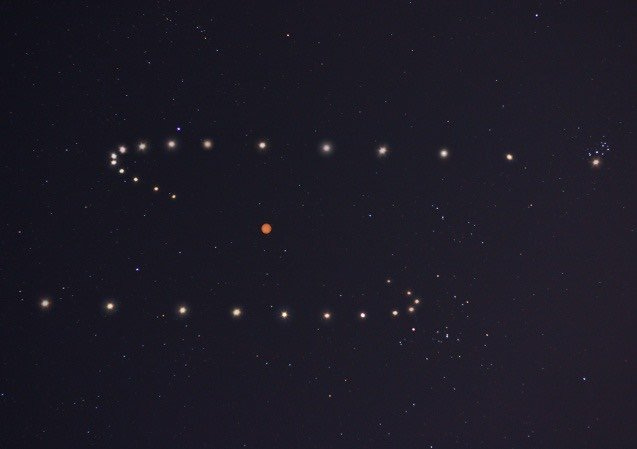
There are 13 Venusian orbits within the greater 8 year planetary period which in turn comprises part of a longer 40 year cycle. In its 8 year planetary period Venus conjoins the Sun at 5 points in the zodiac. When plotted geocentrically these 5 points are seen as the Pentagram or Rose Petals of Venus. The inward loops mark the retrogrades with the outward or wide loops showing the path when Venus is direct.
References
George, Demetra. Ancient Astrology In Theory and Practice: A Manual of Traditional Techniques, vol 1. Rubedo Press, 2019.
NASA.gov
EarthSky.org
This article was first published on my website in August 2023. I wanted to share the updated version along with audio of me reading the text to my newsletter subscribers. Hope you enjoyed! Let me know your thoughts below…




